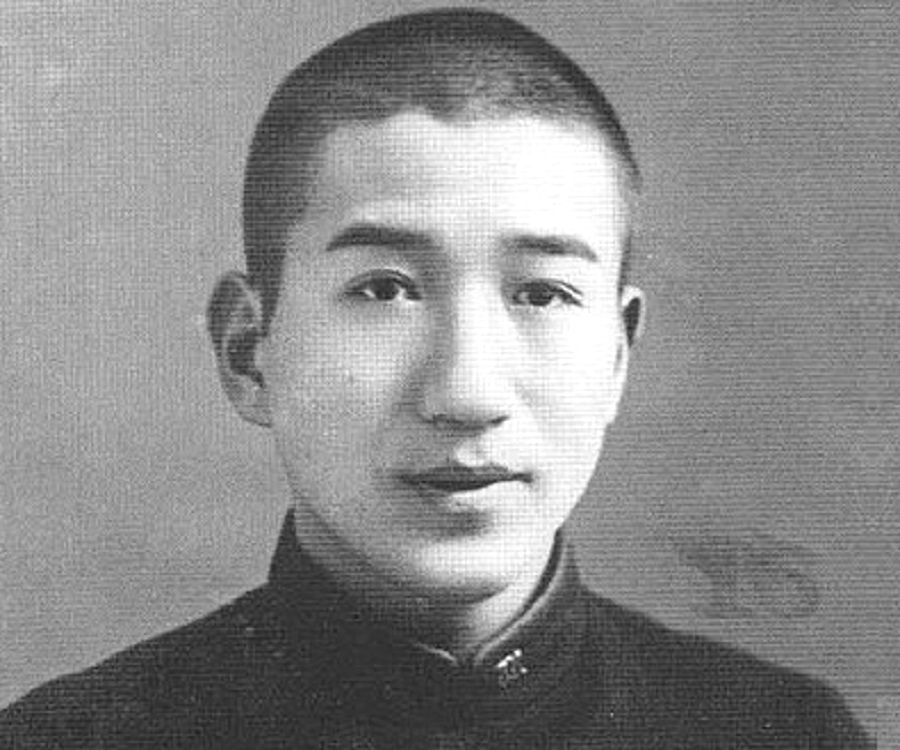
‘As he would have been first to admit, by ordinary standards Osamu Dazai (1909–1948) was not what most of us would call a “decent” man. In the words of poet and critic Kenneth Rexroth, his was an “extremely disorganized” life. Though for sure the adjective applies, Rexroth might as accurately have said “supremely” or even “magnificently,” for Dazai’s life was nothing less than a monument of disorganization, a litany of self-inflicted wounds and disasters culminating in not only his own but two other suicides.
‘Born Shūji Tsushima (he acquired his pseudonym in 1933) to an upper-class Japanese family, from an early age Dazai demonstrated a precocious talent for writing. He was a diligent student and seemed bound for success. Things took a turn for the worse, however, starting in 1927 when his literary hero, Ryunosuke Akutagawa, committed suicide. He started neglecting his studies. Before long the pattern of Dazai’s life was established, with him failing at school, squandering his allowance on alcohol and prostitutes, dabbling in Marxism, and courting—symbiotically—women and suicide.
‘You would not expect all of this “disorganization” to add up to a career of any sort, let alone that of a distinguished and remarkable author whose works are considered to be classics of Japanese literature, and for whom a prestigious literary prize is named. But that only goes to show that—when it comes to artists in general and in particular to literary artists—“ordinary standards” don’t apply.
‘If I single out literary artists, it’s because unlike (say) Picasso, whose personal flaws and disasters were relevant to his art only insofar as they distorted its subjects, Dazai made his flaws the very subject of his art. So closely do his novels and short stories hew to his personal defeats, disasters, disgraces, and debacles, reading them one gets the ominous feeling that he lived as he did at least partially to furnish himself with a subject, namely dissolution; namely his own. At times he seems to revel in and even to relish that dissolution, as if it were a drug that—like the heroin he started taking in his twenties—he couldn’t resist, not because it made him feel good, but because it made him feel human, which is to say, flawed. Dazai could only access his humanity, or at any rate his literary personae, through his personal failings. Hence his addiction, one that led him to seek ever greater depths of dissolution. Yet his personal failings were his artistic triumph.
‘Nowhere is this more evident than in his masterpiece, No Longer Human, the last novel Dazai wrote, and which was being published in serialization when its thirty-nine-year-old author committed suicide in June of 1948. Ranked as one of the all-time bestsellers of Japanese fiction, the novel, structured as a series of notebooks bequeathed by their author to a bar hostess he met as a younger man, tells the story to age twenty-seven of Oba Yozo, a young man almost entirely out of sync with society as well as with his own feelings, a man who lives in dread of exposing his “true self” to others, and therefore cannot be fully human. Incapable of comprehending social protocols and signals, and therefore unable to engage successfully in “normal” relationships, instead he adopts the postures of a buffoon, an amusingly cheerful facade by way of which he hides his deep anxieties and growing sense of alienation. Meanwhile he neglects his studies, falls under the influence of a callow, bar-hopping dilettante, engages prostitutes, and disappoints and disgraces his family until at last they cut him off. Throughout the narrative women play the Janus-face role of damning angels, always there to rescue Oba while simultaneously dooming him (as in the case of the pharmacist who, moved by his pleas, tears, and kisses, generously supplies him with a new addiction: heroin) to ever deeper levels of damnation. But in “helping” Oba his women likewise pay a price, including one death by drowning in a failed double-suicide (he survives).
‘All of this sounds—and is—fairly gruesome, the more so when one considers that in almost every facet the novel is autobiographical; indeed, it’s hard to find much fiction in it. Some even maintain that Dazai wrote it as a sort of last will and testament, having intended to commit suicide once it was completed.
‘We’ll never know for sure. But that the book is remarkable is something to be certain of. What makes it so in part is its utterly beguiling frankness, a frankness that somehow avoids bitterness and self-pity while not lacking in rancor or humor. For all his failings, despite a monstrous contempt for society’s norms (which strike the narrator as entirely fatuous), Oba emerges as a likable though pitiable character.
‘At times Oba’s inability to connect properly with others seems not only pathological but neurological; we could be reading the notebooks of an autistic, but one plagued by feelings of shame, guilt, and resentment. The complete dissociation of a personality yet capable of feeling is the book’s unique subject. Is it, after all, called No Longer Human (in Donald Keene’s translation Disqualified From Being Human), and it lives unsparingly up to its title. By the end of the three notebooks the “disqualification,” we are told, is complete. By implication nothing remains for the notebook keeper but to throw himself into the nearest river.
‘In point of fact that is what Dazai did. He threw himself not into a river but into the Tawagawa Canal near to his home. But being Dazai he didn’t act alone: he took Tomai Yamazaki, a beautician and war widow, the mistress for whom he abandoned his second wife, with him. Their entwined waterlogged bodies were discovered on June 19, 1948, six days after they hurled themselves into the rain-swollen channel. To this day people wonder if it really was a double-suicide, whether in fact Tomai murdered him and then herself. Though no evidence supports this rumor, it has furnished plots for several novels and films. The one author who couldn’t avail himself of this plot was Dazai himself. But God knows given the chance he would have made something excellent out of it.’ — Peter Selgin
___
Further
Osamu Dazai @ Wikipedia
Dazai Museum
Osamu Dazai @ goodreads
Black Illumination: the disqualified life of Osamu Dazai
Osamu Dazai: genius, but no saint
‘Now I have neither happiness nor unhappiness. Everything passes.’
100 Year Anniversary of the Birth of DAZAI Osamu
An Extremely Disorganized Life: Osamu Dazai’s NO LONGER HUMAN
“La Vie murmurée” : Osamu Dazai, l’écriture et la mort
The Immutable Despair of Dazai Osamu
Why you should read “No Longer Human” by Osamu Dazai
The Power of the Japanese I-Novel: Yukio Mishima and Osamu Dazai
Osamu Dazai: A Great Japanese Author with a Tragic Life
Back in the 1950s, Donald Keene thought he had to apologize
Check out these doodles by legendary Japanese author Osamu Dazai!
Osamu Dazai and the beauty of his literature
Buy ‘No Longer Human’
____
Doodles
(drawn by Dazai in his English and Ethics notebooks in high school)
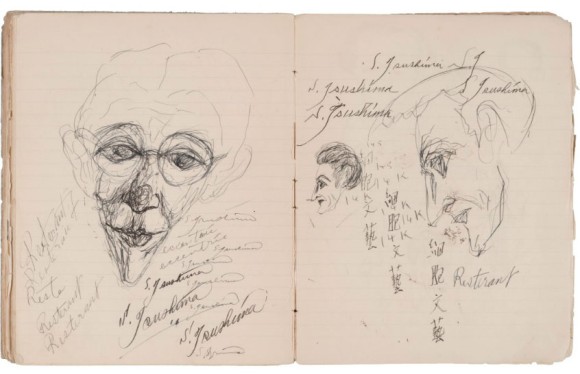
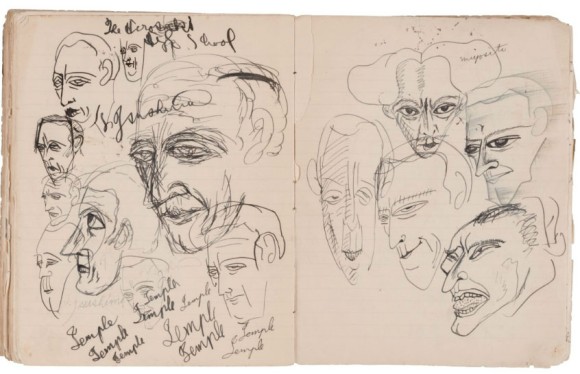
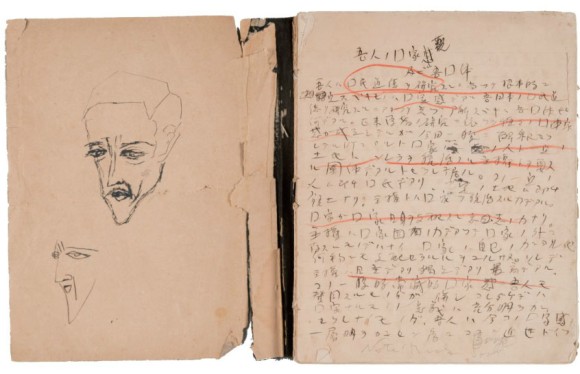
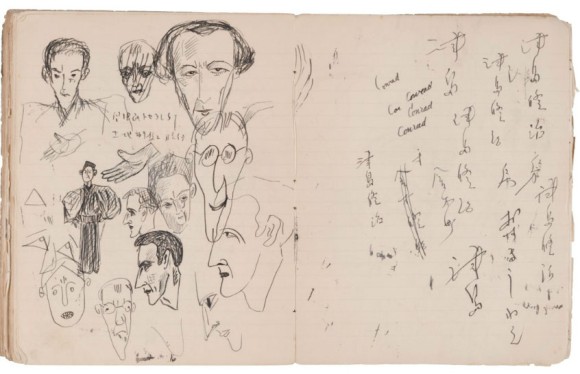

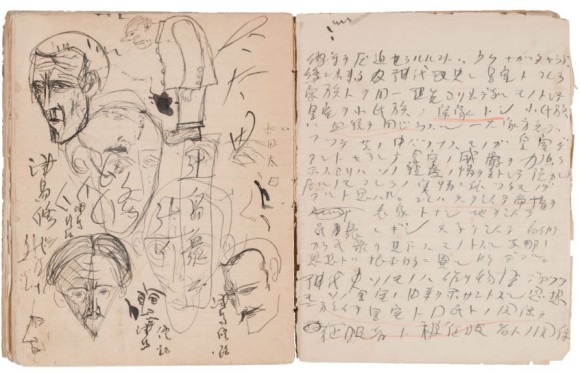

____
Extras
Dazai Osamu Documentary
Trailer: Ningen shikkaku ‘No Longer Human’ (2019)
No Longer Human by Osamu Dazai | A Japanese Classic
No longer human |Osamu Dazai [Bungou Stray Dogs]| Speedpaint
A Suicide Note in a Novel; Osamu Dazai’s No Longer Human
_____
No Longer Human, the graphic novel
Creator: Osamu Dazai
Writer & Artist: Junji Ito
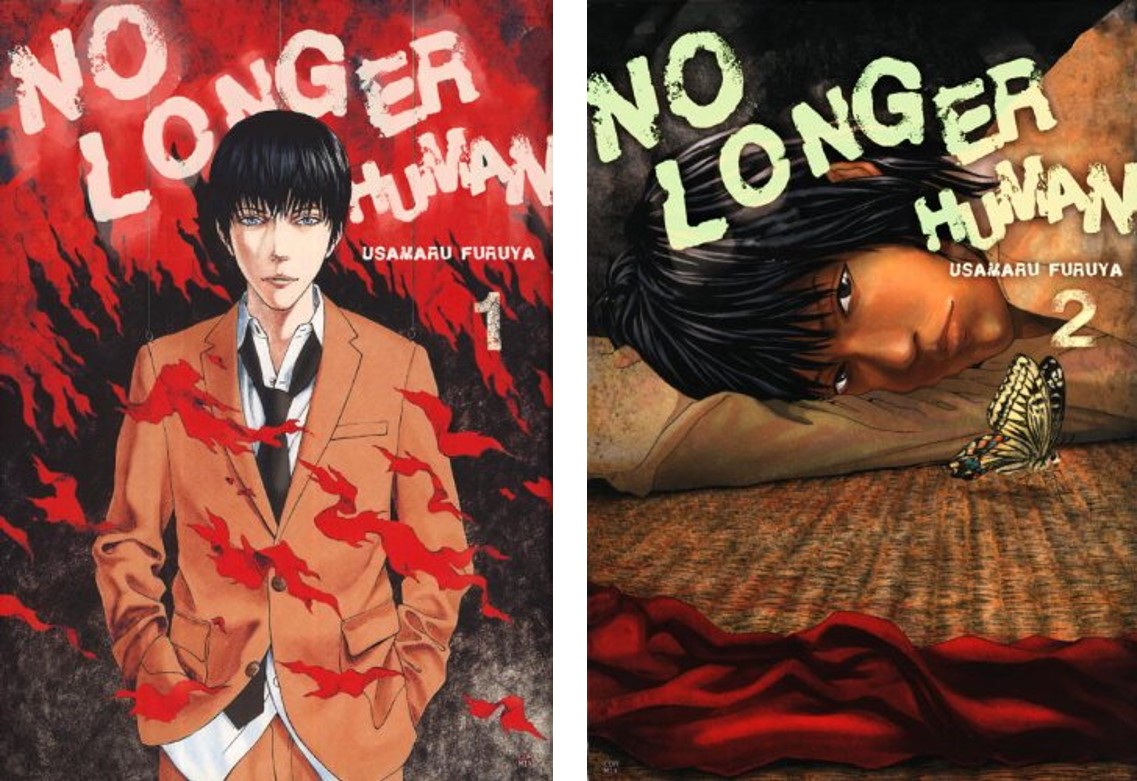
‘Osamu Dazai was a 20th century Japanese novelist whose No Longer Human became Japan’s second best-selling novel. Dazai’s first-person narrated novel is largely autobiographical; the novel’s obsession with death and suicide, as depicted in the graphic novel’s opening pages by Eisner Award winning-horror manga-ka Junji Ito, reflected its creator’s spiraling descent into madness. Ito, whose macabre style uniquely suits the subject matter, adapts Dazai’s 1948 novel to spectacular and stomach-churning savagery.
‘Yozo Oba is a man afraid of revealing his true self to others; he hides behind humor and clownish mockery. In high school, Yozo befriends a homely loner named Takeichi but becomes scared when Takeichi glimpses Yozo’s true nature behind his clowning. When a joke gone awry results in Takeichi’s suicide, Yozo feels liberated and indulges in destructive behaviors that include boozing and womanizing, and “In the morning, I was again the shallow, fearful clown.”
‘Misfortune greets him after a failed lover’s suicide pact, and the ghosts of his past indiscretions come back to haunt an increasingly fragile pscyhe that unravels with each subseuqnet relationship. At one point, while on another suicide bend, Yozo despairs: “At most, society was the individual…it was not worth fearing. I believed this, but when a crowd of individuals formed, the pressure increased tenfold, a hundredfold.”
‘No Longer Human is a perfect vehicle for Ito’s talents. Ito infuses the misfit Yozo and text with relish and ferocity, providing a vivid and startling portrait of the anxiety and psychoses that set Yozo’s (and correspondingly, Dazai’s) moral compass adrift in a sea of self-loathing and self-destruction. The image of Takeichi and the women who have served as his sacrificial lambs confront Yozo at every turn.
‘Ito puts their visages onto the faces of his hapless victims and on the faces of children he meets along his path and in dreams. Ito remains largely faithful to the original text but takes an interesting turn when he sets up a meeting between the fictional Yozo and original author Dazai to break the fourth wall. The ghostly pallor of Yozo’s face, whose eyes are cloaked in sunken shadows, is the mirror that Ito uses to compare Dazai’s own mental decline.
‘No Longer Human is a dark and depressing novel whose supernatural bent plays well into Ito’s capable hands. While not the easiest read to digest, Ito gives the novel’s delicate subject matter its proper due. His vision meshes well with Dazai’s to become a seamless, powerful statement on the darker impulses of humanity.’ — The Comix Beat (Japan)
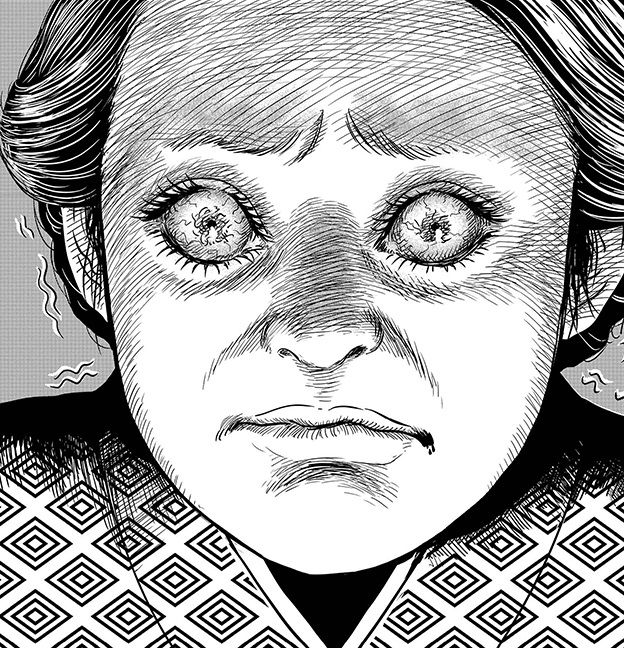
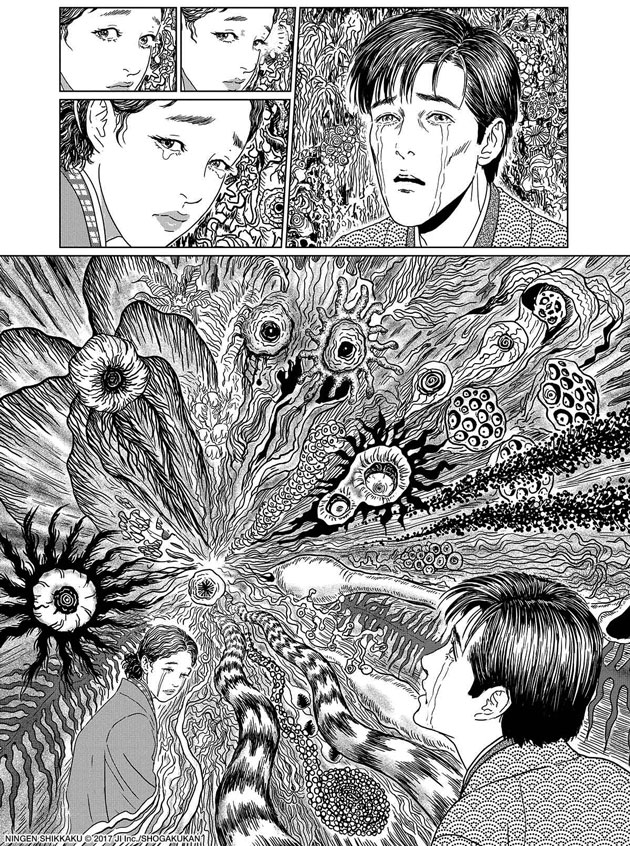



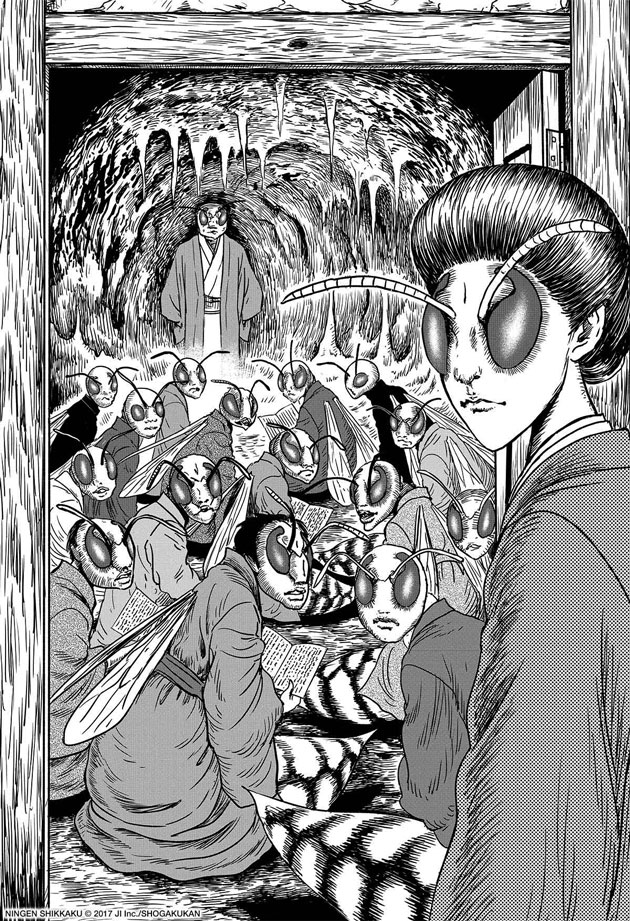

____
Interview with Donald Keene, Translator of Osamu Dazai
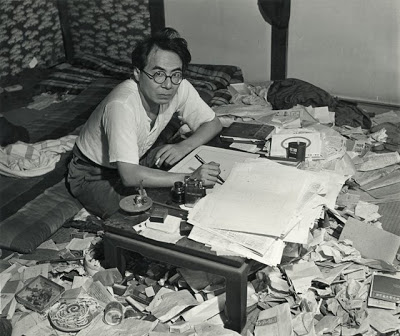
Q. You learned Japanese during a time when it was very difficult for an American to do so. Today though, it is easier than ever with the majority of American universities offering some kind of Japanese/East Asian Studies program. Did you ever think that your field would be this big?
When I began the study of Japanese, there were only four or five American universities where Japanese was taught. There was about the same number in Europe. A typical class in Japanese had few students, and they included graduate students who were not really interested in Japan but studied the language because they believed that studies of China in Japanese might help them.
When I was first at Cambridge, people would ask me why I taught the language of a country of imitators. This was a general impression of Japan. The change in attitude was the largely the result of the wartime training in Japanese by the U.S. Navy and Army. Only a small per cent of those who then learned Japanese used the language after the war, but those who stayed with it became the teachers of numerous students.
Q. As mentioned in Chronicles of My Life, the literature of Japan is what introduced you to the language and culture. In recent years, there has been a considerable otaku boom of Japanese anime, manga, and video games in the West. Do you think that these forms of media are a positive way of getting new generations interested in Japan?
It is difficult for me to answer your question on popular forms of art. I do not look at manga, etc. and they have paid no part in my education. My students have never told me that they were inspired by manga to study Japanese literature, but it is possible that they were embarrassed to tell me of the humble beginning of their interest.
Q. The Tale of Genji in particular has had a strong impact on you, specifically with Arthur Waley’s original translation. While no doubt a major literary achievement, some purists have criticized Waley for omitting certain parts of the narrative and creating his own “flowery” prose. What are your thoughts on his translation?
The Waley translation has played such a place in my life and is so beautiful as English that I continue to enjoy it, though I know of its errors, omissions, and its additions to the original text. I am glad, however, that more accurate and faithful translations exist.
Q. The other famous translation for Genji is by your colleague Edward Seidansticker, while another one exists by Royall Tyler. And recently this year, a translator named Dennis Washburn released his own version. What is your overall opinion on these various translations and how do they compare to Waley’s? Have you ever considered writing your own translation?
I admire the Seidensticker translation though it does not have the magic of Waley. There are errors in the translation that Tyler revealed in his translation which, as far as I can tell, is without mistakes. Its accuracy once in a while results in unpoetic expression, but I recommend it. I have not read the translation by Washburn and cannot comment on it. I never thought of translating the work because I worshipped Waley.
Q. You also briefly mentioned Ooka Shohei in your autobiography. His novel Fires on the Plain (Nobi) and its subsequent film adaptation truly moved me. Have you read this particular novel yourself?
Yes, I have read several works by Ooka Shohei including Fires on the Plain which I think is his masterpiece.
Q. Along with its literature, Japan has a rich history of cinema and is famous for its renowned directors like Akira Kurosawa and Masaki Kobayashi. Do you watch many Japanese films?
I saw many Japanese films during its golden age, but have seen few in recent years, partly because I have lost the habit of going to films. I am more devoted to opera, though I know I should see more films.
Q. Many considered renowned film critic Donald Richie as the definitive authority on Japanese cinema. Did you ever meet him at any point?
I knew Donald Richie fairly well because people kept confusing the two Donalds. We occasionally got mail intended for the other person. He did a great deal to give status to Japanese films, but I could not understand why he never learned to read Japanese.
Q. You were friends with Yukio Mishima and in 1985, Taxi Driver screenwriter Paul Schrader released a film titled Mishima: A Life in Four Chapters which was a biopic that adapted several of his novels. Have you seen this film, and if so, does it paint an accurate picture of Mishima?
I saw the film about Mishima and liked it, but I do not remember it well enough to comment now.
Q. Moving back to Chronicles of My Life, I strongly related to your views when you called yourself a pacifist. Have you continued to keep this view today?
I am still a pacifist and recently have written a number of articles opposing the change in the Japanese constitution to permit Japan to have an army and take part in warfare.
Q. Chronicles of My Life also featured some beautiful artwork done by Akira Yamaguchi. What was the creative process behind this aspect of your book?
I was delighted with the illustrations by Mr. Yamaguchi, but they had no part in the writing of my book. Whenever I hear of a show of his works, I try to attend. The Japanese edition of the autobiography has none of his illustrations, making the book far less attractive. Probably the publishers wanted to save money.
Q. There’s the notion that a foreigner in Japan will always be a perpetual outsider and never accepted as “truly Japanese.” After living in Japan for so long, have you experienced this in any way?
For years I was bothered by the Japanese attitude towards foreigners, even those who knew the language, but things have changed, and I believe I am now treated like a Japanese. This means, of course, that I must obey the rules of Japanese culture. Of course, taxi drivers sometimes ask me, as a foreigner, if I can eat sashimi, but I am well enough known in Japan for most people not to ask that question anymore.
Q. Do you follow Japanese politics? Recently, Prime Minister Shinzo Abe has called for an expansion of Japan’s military powers. What are your thoughts on this?
I am normally not interested in politics, but I have been upset by the policies of the present Prime Minister. I have the impression that he and his party are willing to involve Japan in a war.
Q. These days, what are you up to? Do you have any new translations in the works?
I have recently finished a book on the poet Ishikawa Takuboku. I don’t know when it will be published. The title has not been established.
Q. Lastly, do you have any advice for people interested in Japanese language and culture?
My advice to students of Japanese is not to get discouraged when they find they are still not able to read a newspaper or a poem. Japanese is a hard language to learn, but one should tell oneself that if one keeps at it, a day of enlightenment will arrive.
___
Book
 Osamu Dazai No Longer Human
Osamu Dazai No Longer Human
New Directions
‘Portraying himself as a failure, the protagonist of Osamu Dazai’s No Longer Human narrates a seemingly normal life even while he feels himself incapable of understanding human beings. Oba Yozo’s attempts to reconcile himself to the world around him begin in early childhood, continue through high school, where he becomes a ’clown” to mask his alienation, and eventually lead to a failed suicide attempt as an adult. Without sentimentality, he records the casual cruelties of life and its fleeting moments of human connection and tenderness. Semi-autobiographical, No Longer Human is the final completed work of one of Japan’s most important writers, Osamu Dazai (1909-1948). The novel has come to “echo the sentiments of youth” (Hiroshi Ando, The Mainichi Daily News) from post-war Japan to the postmodern society of technology. Still one of the ten bestselling books in Japan, No Longer Human is a powerful exploration of an individual’s alienation from society.’ — ND
___
Excerpts
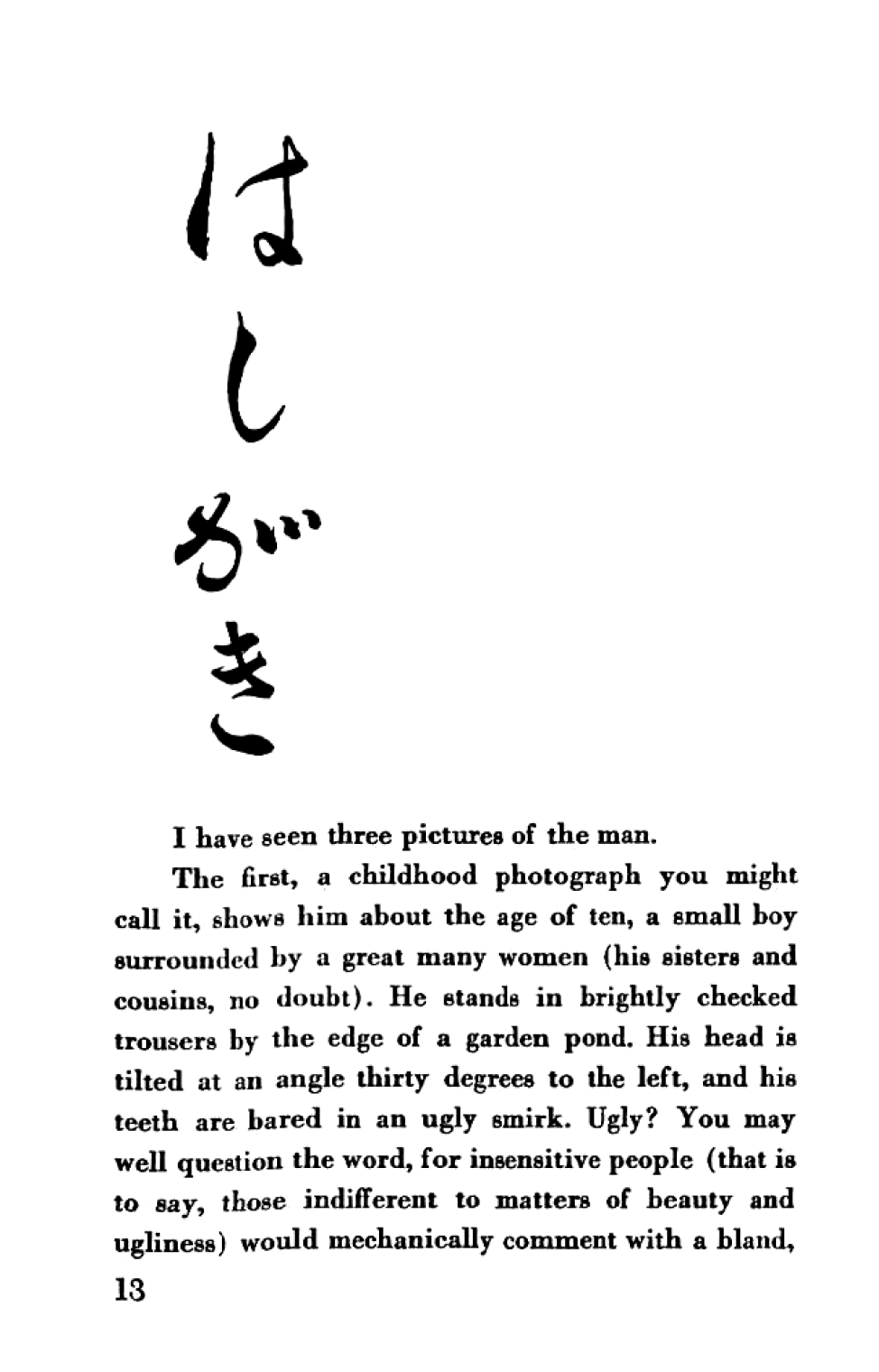

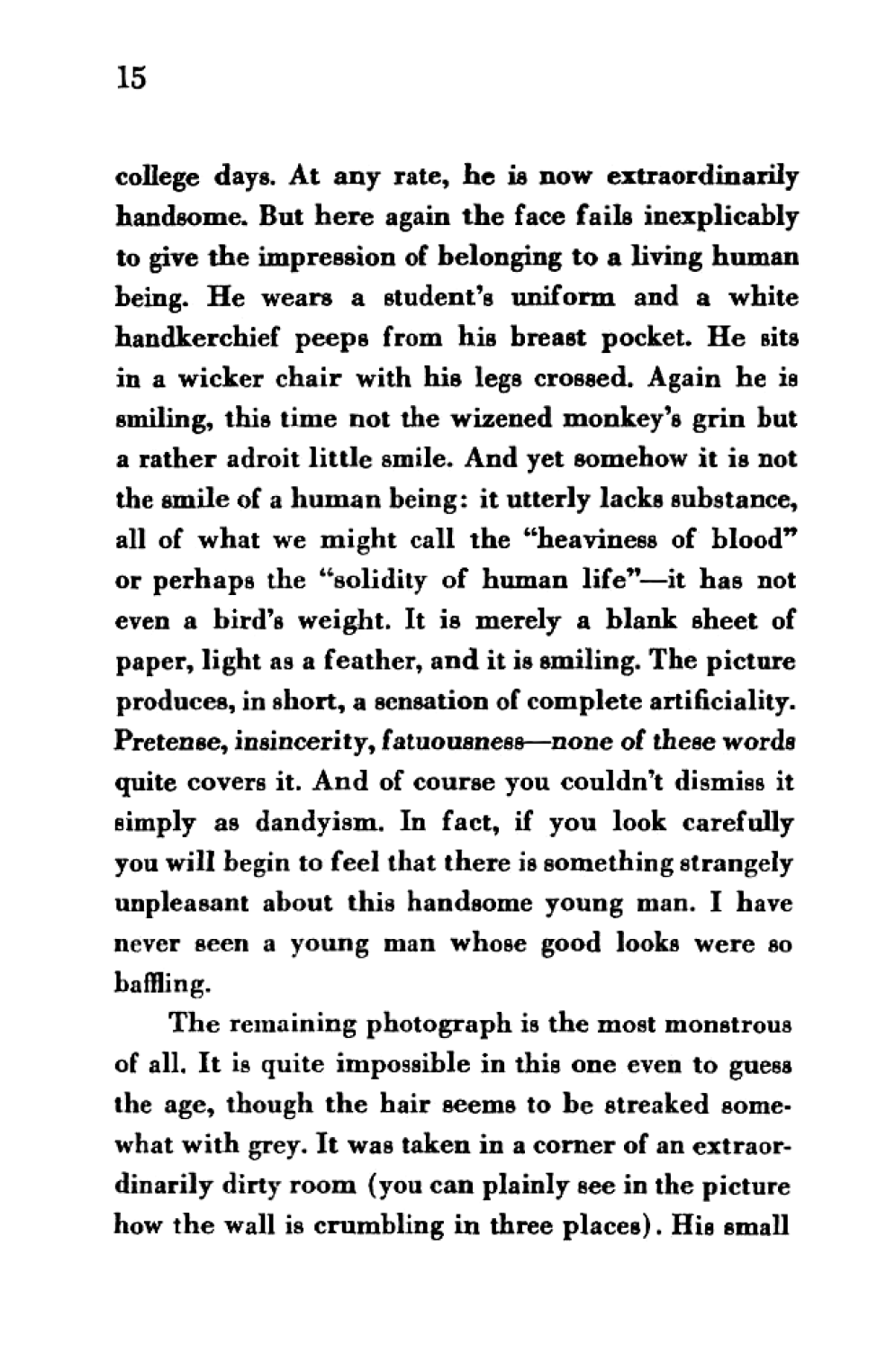
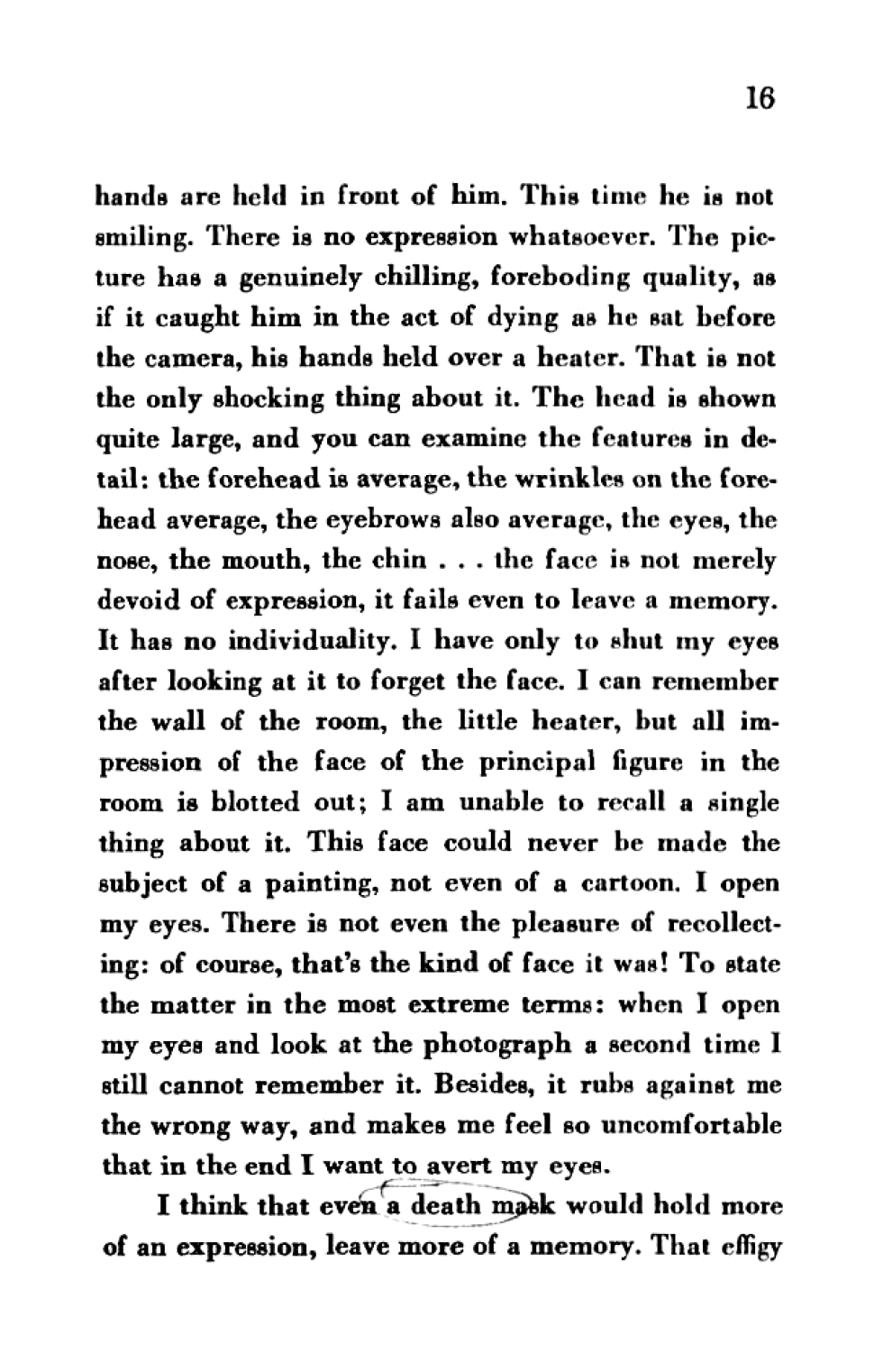
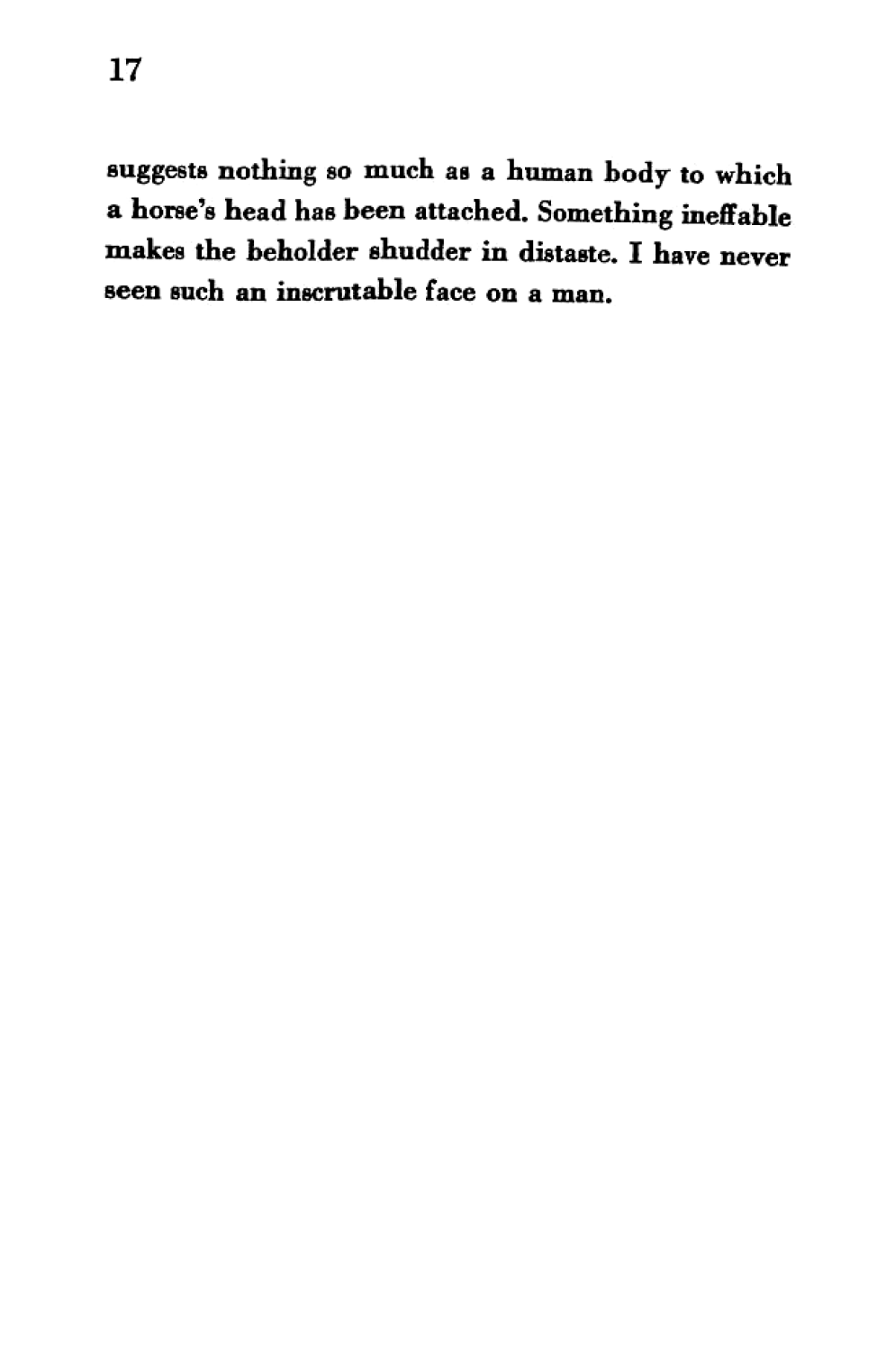
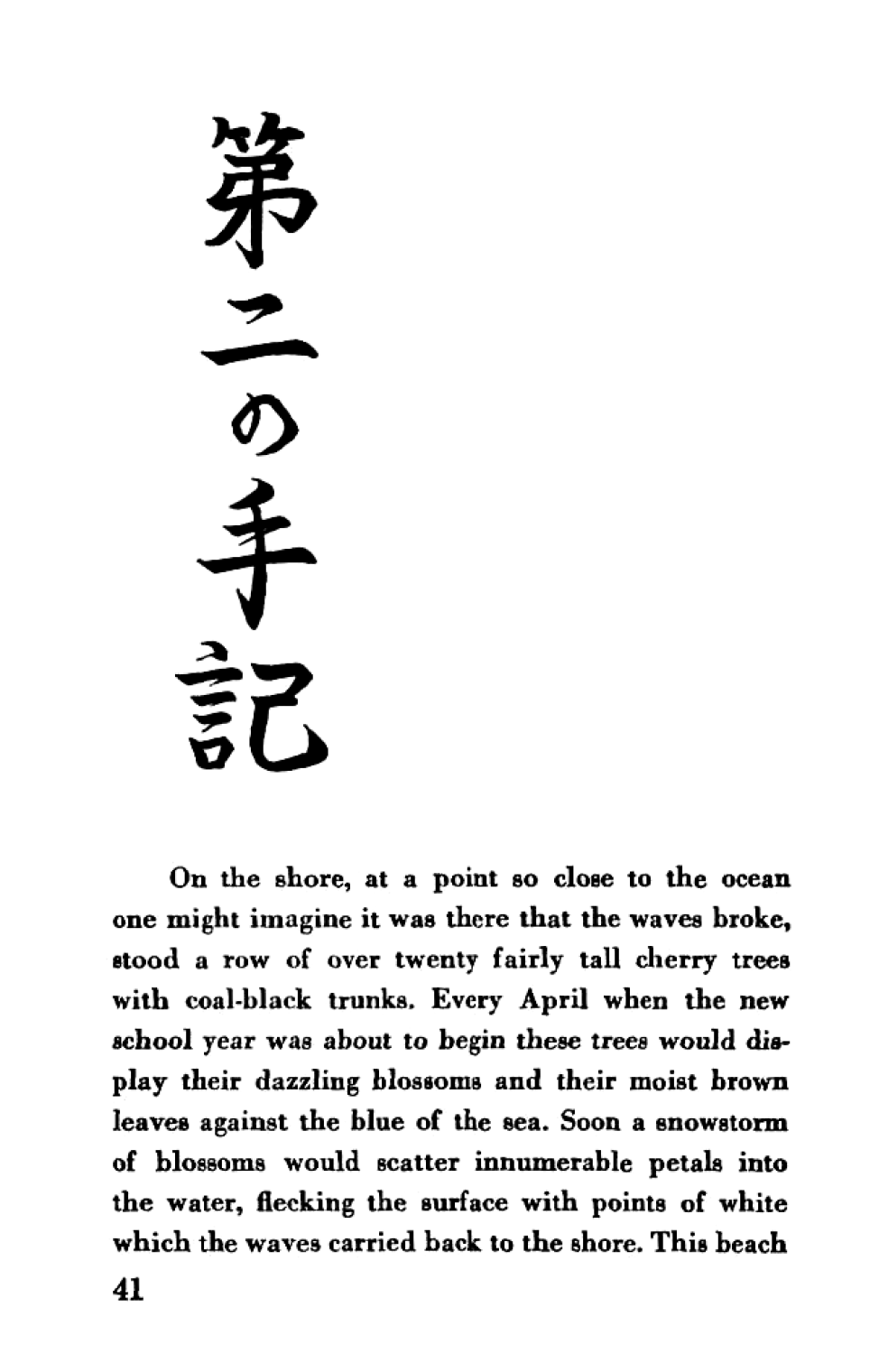
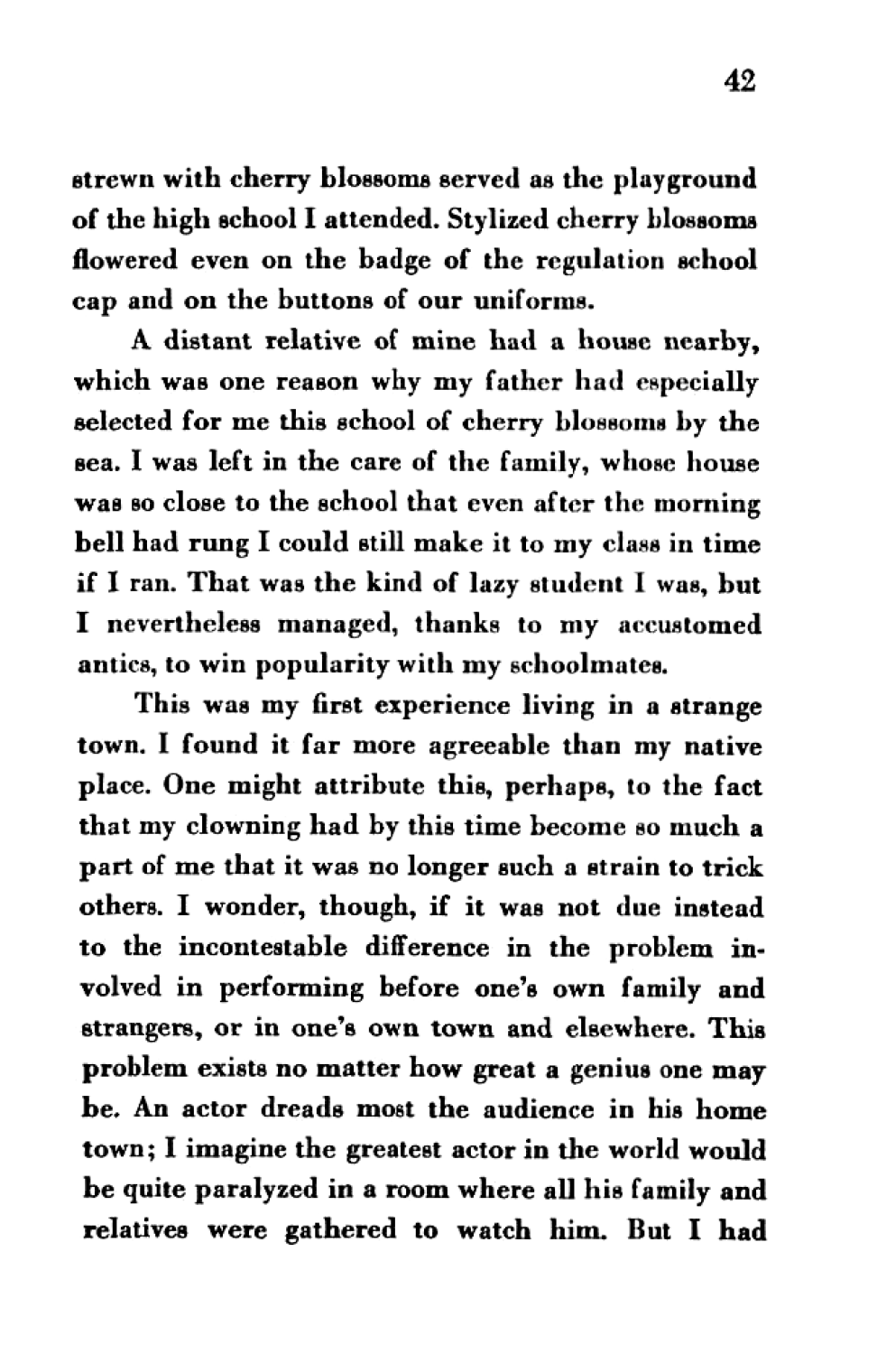
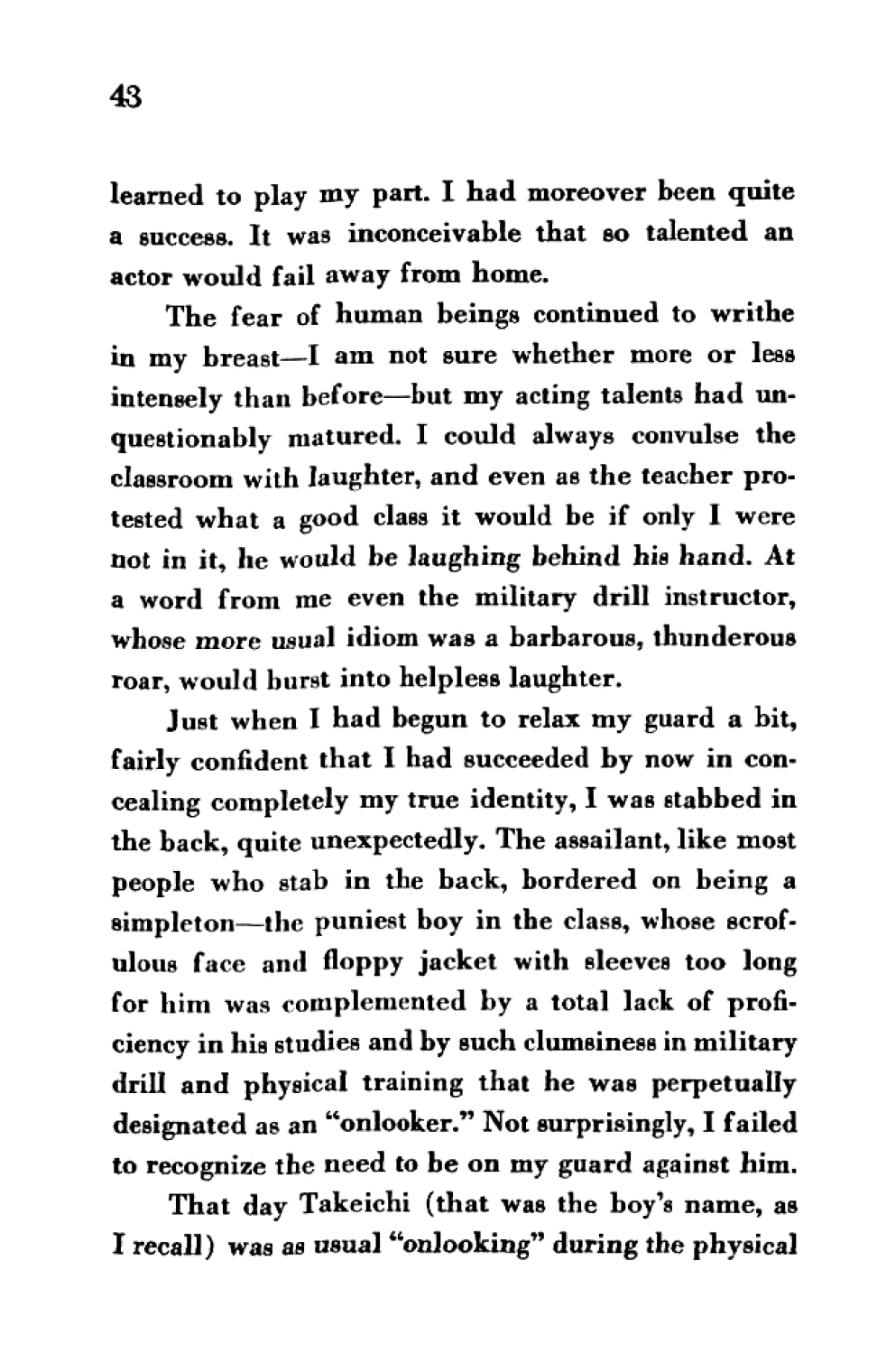
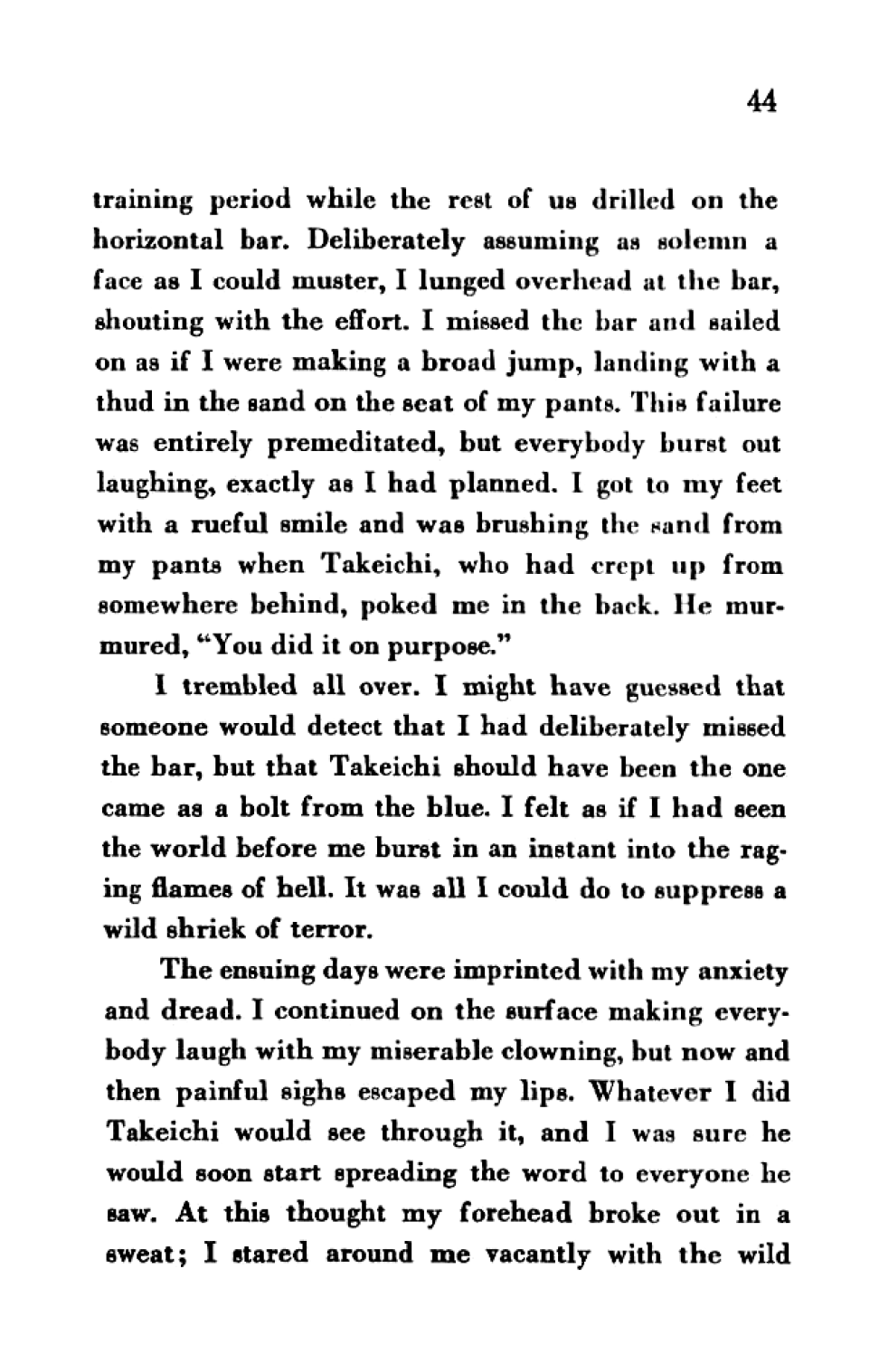
*
p.s. Hey. ** Dominick, Hi, D!!!! Oh, you still are going to put out an issue. That’s very exciting! It sounds like you’ve come up with the best of both worlds, as they say. Yesterday the rain vamoosed, and it was glorious out. Amazing how absolute normalcy can be so exciting. It won’t last — the invigorating newness of the usual, I mean — but it’s lovely now. I’m sorry the rain is being so clingy there. Now that would be a nice thing to find inside an eroding VK. At one point, there was going to be movie made of ‘Closer’. This was around theme of ‘Diorama’, and Daniel Johns agreed to write the soundtrack/ score, which I was super excited about, but the director could never raise the funding so the project died sadly. Love turning the young Daniel Johns into a humanoid pastry and jumping onstage at a Silverchair concert while they’re playing ‘Freak’ and gobbling him down as he sings the lines ‘Your baby’s got rabies / Sitting on a ball / In the middle of the Andes’, G. ** David Ehrenstein, Yes, P. Adams Sitney is still alive, in his late 70s, and, as far as I can tell, still Dean of the Faculty at Princeton University. ** Steve Erickson, Yesterday here was sunny and completely wonderful, thanks. I even ate at my favorite Paris Mexican restaurant, El Guacamole. Someone made a spreadsheet of the interesting films playing at theatres here right now, and I’m about to go scour it. I know a Kiarostami retrospective starts today at the Pompidou. Oh, yeah, could hear the Arabic scale now that you mention it. Nice. I have not read ‘Detransition, Baby’, and I intend to, although I’ve heard very mixed things about it. How is it for you? ** Wow, that was fast. Today I spotlight the great Osamu Dazai’s arguably greatest novel. Read it? See you tomorrow.




 Now available in North America
Now available in North America 
Hi Dennis ! Thank you for this post. This book has been on my (ever growing) list of books I have to read for a long time. It looks good.
Other info : John Keene’s Annotations has just been published in French, by the great press Cambourakis. Last time I checked, they didn’t have it at my favorite bookshop, Les cahiers de Colette. Sad, since it looks really good. Recently, I’ve been reading some of Emmanuel Hocquard’s things. I like it. Un privé à Tanger, for example.
Other info : there’s a Kiarostami retrospective at the Pompidou. I managed to get tickets for the 24 frames screening tonight. I saw 24 frames when it was broadcasted by Arte. I loved it. Can’t wait to watch it on a big screen.
The aquarium has reopened. But I don’t like the aquarium anymore, so I’m looking for another job. But if you want to come, you’re welcome, it’s always free for you, just send me an e-mail.
Sun + some clouds today, it’s OK…. Have a great friday.
I read this book for the first time in 2020. It is SO good. I found some listicle that was titled something like. ‘Novels About Suicide’ or something so purchased most of them and worked my way through. Seemed like a very 2020 tone thing to do lol – that ‘ Last Words from Montmartre’ by Qiu Miaojin was also on there. The k going to watch all these video clips. Thanks for this. You read that Qiu Miaojin book?
The portrait of the writer working at his table with paper and books on the floor is not Dazai. It’s the writer Ango Sakaguchi, and according to Lun*na, a great writer. But back to Dazai, he’s one of my favorite all-time writers. His short fiction is remarkable. I strongly recommend “Self-Portraits” which is out-of-print, but easily found on the Internet. Some years ago I spent over $100 on a taxi drive to go to Dazai’s mountain retreat in Japan where he wrote many of his books. Totally a fan geek thing for me to – and the only thing they sold there in the pop up gift store was a bumper sticker. Still, it was a thrill to be in his studio space. There is something about his short stories that inspired my writing. Perhaps it is approach to his past, which is a mixture of fiction and truth. Amazing writer. Thanks for today’s blog.
This does look very great and has been added to my to-read pile.
Just found out that the new episode of my radio show Play Therapy will be broadcast next Friday 28th! Still needs to be recorded yet, but I’ve been putting a playlist together and I look forward to sharing it with the unsuspecting world out there.
Dennis, Hahaha, about Mark Dennison’s tunnels. And he does have some cavernous ones. 😀
Yes, exactly. You know me well. I told the illustrator to think of it as his own creative project and do what he wants.
So we woke up this morning to three of David’s tires being slashed. Ugh.
Still haven’t heard back from that kerazy vet. I’ll call her next week.
Otherwise, have a good weekend. I think I will. 😀
I should reread this book one day (I did read the Junji Ito adaptation a few years back, very good). I read my 2nd Dazai earlier this month: THE SETTING SUN. Dennis, it’s funny this book comes up though: a friend yesterday asked me for a link to your Top 50 novels. I found someone had posted the list on Goodreads so I sent him that. Later on, looking at the list again, I saw it was the one you posted on your blog years ago: I knew that because NO LONGER HUMAN was on there, a book you dropped off when you updated the list for UGLY MAN.
Hi!!
I just thought about this the other day — how normalcy feels so foreign now that the simplest things became these serious sources of pleasure (an open café, etc.). I’d like to keep this wonder. This ability to appreciate what I usually don’t even notice. But I, too, think it’ll fade in time, sadly.
Oh, no! It sounds like it could’ve been a dream project! Fuck! Now, I feel a little sorry for past Dennis and present me, haha.
Hahaha, I feel your love on so many levels right now! Perfect! Thank you! Love finishing work on a fucking mental health nursing dissertation at 11.10 pm and feeling like his eyes are tiny, hard balls of chewing gum about to fall out of his face, Od.
Hey Dennis. Interesting post today. Always a shame when ppl are the center of their own undoing, even when it results in great art. I will look up some of his stuff and see if I can find any from the library. Hope all is well with you in Paris.
Ian
I haven’t started DETRANSITION, BABY yet. But I’ve heard great things about it.
Is there a Paris equivalent to Screen Slate?
I’ll be reviewing NOBODY for the Quietus. I hated it, and my editor really wants me to tear it to shreds while keeping a sense of humor. (On Letterboxd, I wrote a paragraph-long review in the voice of the son of Bob Odenkirk’s character.)
Marvelously weird stuff today.
Nice to know p.Adams is still around , We never really got along but I respect his cultural tenacity. Plus I love hisperformance in Snow’s masterpiece “Rameau’s Nephew By Diderot (Thanx toDenis Young) by Wilma Schoen”
His willingness to go along withGregory markopoulos’insistence on wrting himself out of American experimental film history has always puzzled me. But then Gregory has always pussled me.
Hi Dennis,
So happy to hear you enjoyed the Cali Girls wormhole, I’m working on and hoping to put out some more music soon! I’ve been good though, writing a few pieces of short fiction as well that I’m feeling good about – one about a musician without a personality mindlessly wandering through a music video shoot and the other about being a dog for Jordan Wolfson. I also started working at a cinema, so that’s taking up a lot of time too. I’m super glad that you have dates for the amusement parks reopening, hopefully that is a real bit light starting to crack at the end of the tunnel. Speaking of tunnels, I enjoyed the tunnel post cause I’m quite claustrophobic and go through phases of fear of tunnels! Also excited to learn about Osamu Dazai today as I love Junji Ito but don’t know Dazai. Hoping you’re basking in Paris’ fresh freedoms ? Sending all my best as always, Gus